
Edward Winter
(1986, with additions)

George Koltanowski
The public will always love George Koltanowski, believing him to be one of Them who has stayed one of Us. The ‘International Wizard of Blindfold Chess’ has delighted by his regular displays, knight tours and indiscretions about the masters. Avuncular and impish, he has apparently understood that the world will forgive an Accessible Character almost anything.
There is indeed much for which forgiveness is required, but is Koltanowski aware of the damage his having a good time has caused? To speak only of his writings, he leaves behind a trail of howlers that even John Graham might envy. Anyone suspecting this to be an exaggeration should read the piece on Klaus Junge on page 89 of the February 1976 Chess Life & Review, together with its wholesale demolition by Paul Schmidt on pages 212-213 of the April 1976 issue. This concluded, ‘About the only correct reference to Klaus Junge in Mr Koltanowski’s article is to his chess genius ...’ Among Sunny Kolti’s errors was a claim that Junge was ‘stabbed to death in a chess club fight in 1942!’ He actually died in combat in April 1945, at the very end of the Second World War.
‘Everywhere, it seems, adventure and anecdote awaited me’, he writes on page 37 of Adventures of a Chess Master, neglecting to add that some of the anecdotes lurked in contradictory forms. An example is the ‘First Flohr’ yarn reported by him in a CHESS article (see C.N. 887, on page 121 of Chess Explorations) as having been told to him by Lilienthal. But on page 45 of his book With the Chess Masters (Falcon Publishers, 1972) he relates that Flohr himself was the speaker. The Koltanowski touch is equally at home with trivia and tragedy.
A (relatively brief) selection of examples of general carelessness in With the Chess Masters: Page 9: ‘Mizowitch’ at London, 1922?? Page 10: ‘Giuco ... Pianisimo’. Pages 15-16: The best part of two pages are devoted to a story of how L. Steiner cheated against Colle at ‘the Budapest International, 1928’. Neither player was there. Page 48: ‘Twice Tarrasch mounted a campaign to take the world title from Lasker – and twice Lasker beat him badly.’ When was the second time? Page 49: ‘My first encounter with Dr Tarrasch was in 1924 at the International Chess Tournament in Merano, Italy. I was in my early teens.’ Yet he was born in 1903. Page 54: He appears to believe Scotland is in England. Pages 67-68: Another cheating anecdote, according to which Dyckhoff pretended only to have drawn against John at Hanover, 1902, so that his close rival Bernstein would not go for a win against Kagan. Yet Dyckhoff and John did only draw. Page 80 and page 81: ‘R.F. Mitchell’. Presumably R.P. Michell. Page 90: ‘James Cross’. Rupert Cross would be correct. Page 92: for (Emanuel) Sapiro read Sapira. Page 100: ‘Marotzy’ (twice). Page 101: ‘Bekker’ (twice). Page 101: Flohr did not play at Carlsbad, 1929. Page 101: ‘ ... ahead of Reifir, Spielman, Astalosh and the younger Widmar’. Read: a) Rejfíř, b) Spielmann, c) Asztalos, d) Vidmar. Page 101: Alekhine and Euwe did not play at Moscow, 1935 (it is even said that there Menchik ‘beat Euwe twice!’). Page 141: Rejfíř has a wrong year of birth. And so on ...
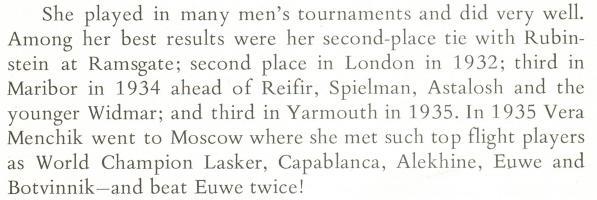
Koltanowski on Vera Menchik, from page 101 of With the Chess Masters
Chess Enterprises have just re-issued Adventures of a Chess Master, under the title In the Dark, a fair description of Koltanowski’s historical scholarship. (The earlier book [page 10] gave the wrong year of birth for Blackburne, and Koltanowski has learned nothing since 1955 to make him change it.) Apart from very minor textual alterations and two new chapters, In the Dark is little more than an algebraic version of Adventures ..., and even the 1955 Foreword with its opening words ‘I first began to plan this book twenty-five years ago’ has, misleadingly, been left untouched.
Finally in this catalogue of censure, one may mention Koltanowski’s insistence (notably in chapter eleven of In the Dark) on publishing unprintworthy games, his reference (page 189) to Morphy’s famous opera game against the ‘Duke of Brunswick and the Count de Mongrédien’ and his deliverance of such divine prose as (page 179): ‘By playing sharp I felt that I would get a great number of games over with before any tired feeling would overtake me.’
Note: The above article was written in 1986 (C.N. 1234) and appeared on pages 159-160 of Chess Explorations. In 1999 an attempt to defend Koltanowski (regarding a single matter – Lasker v Tarrasch) was made by Eric Schiller, on the basis of a memorable piece of mendacity. And typical as well as memorable. What Schiller lacks in intelligence he makes up for in guile.
The above-mentioned ‘First Flohr’ story had already been discussed in C.N. 887 (see page 121 of Chess Explorations):
A pointless tale, often repeated (e.g. Chernev’s The Bright Side of Chess, page 19), is that at Nottingham, 1936 Salo Flohr thought he would win all the prizes because he heard the lift operator say ‘First Flohr, Second Flohr, Third Flohr’.
Before the story is printed yet again, it would be as well to mention that it had already been given in CHESS for 14 November 1935 (page 115), where the witticism is credited to Lilienthal. Since the writer of the article in question is George Koltanowski, one must be doubly sceptical.
On page 17 of Chessnicdotes Koltanowski presents the following score, Capablanca’s shortest tournament win (v E. Colle, Budapest, 1929): 1 d4 Nf6 2 c4 e6 3 Nc3 Bb4 4 Qb3 Bxc3+ 5 Qxc3 Ne4 6 Qc2 d5 7 Nf3 O-O 8 e3 Bd7 9 Be2 Re8 10 O-O e5 11 cxd5 Resigns.
Koltanowski comments:
‘The resignation seems rather early. True, Black has lost a pawn, but Colle felt that was too much of a handicap against the great Cuban.’
In reality, as shown on page 53 of the tournament book by Tartakower, Black played 8...Nc6 and resigned at move 11 because a decisive loss of material was unavoidable.
(1837)
An additional item on page 302 of Kings, Commoners and Knaves:
An excerpt from page 19 of “En Passant” Chess Games and Studies by George Koltanowski (Edinburgh, 1937):
‘When Philidor, the Frenchman, in 1816 played six games blindfold the Press went mad, thinking it an eighth wonder …’
It certainly would have been. Philidor had died in 1795.
‘Dunkelblum’ is frequently given as the name of the player who lost two of the most frequently published games featuring the late George Koltanowski, i.e. the 13 Qd8+ brilliancy (‘Antwerp, 1923’) and this more sophisticated encounter (‘Antwerp, 1929’): 1 e4 e5 2 Nf3 Nc6 3 Bc4 Bc5 4 O-O Nf6 5 d4 exd4 6 e5 d5 7 exf6 dxc4 8 Re1+ Be6 9 Ng5 Qd5 10 Nc3 Qf5 11 Nce4 Bb4 12 c3 dxc3 13 bxc3 Ba5 14 g4 Qg6 15 Nxe6 fxe6 16 f7+ Kxf7 17 Ng5+ Kg8 18 Rxe6 Qd3 19 Qe1 Rf8 20 Re8 Qd7 21 Rxf8+ Kxf8 22 Ba3+ Ne7 23 Rd1 Qxg4+ 24 Kf1 Qxg5 25 Rd5 Qh4 26 Rh5 Qf6 27 Rf5 Resigns.
On page 27 of his book Adventures of a Chessmaster Koltanowski gave the former game as played against A. Dunkelblum in ‘an eight-game blindfold exhibition at Antwerp in 1923’. However, on page 35 of Checkmate Strategies (co-authored by Koltanowski and M. Finkelstein) the heading was ‘Antwerp, 1931’. As regards the second game, both books agreed on ‘Antwerp, 1929’, but the former (page 38) gave Black’s name as ‘P. Dunkelblum’ (Koltanowski also referred to ‘my boyhood chum, Dunkelblum’) whereas the latter volume had ‘Dunkelbaum’. Where Arthur Dunkelblum (see page 82 of Histoire des maîtres belges by M. Wasnair and M. Jadoul) may fit in with all this is more than we would dare guess.
The Caro-Kann miniature with 13 Qd8+ was published on page 268 of the September 1931 Wiener Schachzeitung with notes by A. Becker. Black was not identified, but the heading specified that the game had been played in Koltanowski’s record-breaking 30-board blindfold exhibition in Antwerp on 10 May 1931. The first problem here is that Koltanowski gave all 30 games from that display in two of his books, “En Passant” Chess Games and Studies (Edinburgh, 1937) and George Koltanowski: Blindfold Chess Genius (Anaheim, 1990); the brilliancy is not among them.
Secondly, on page 348 of the November 1931 Wiener Schachzeitung Dyckhoff pointed out that the Caro-Kann game had already been played in October 1930 by Tarrasch, in a casual encounter against an unnamed Munich opponent, and had been published in the Stuttgarter Illustrierte Zeitung of 21 December 1930, as well as the Bayerische Radio-Zeitung of March 1931. Moreover, the queen sacrifice line had been given by Blümich in the notes to the game Fajarowicz v Blümich, Leipzig, 24 November 1930, on page 87 of the March 1931 Deutsche Schachzeitung.
Thirdly, there is a discrepancy over the move order. Whereas in Adventures of a Chessmaster Koltanowski gave 1 e4 c6 2 d4 d5 3 Nc3 dxe4 4 Nxe4 Bf5 5 Bd3 Qxd4 6 Nf3 Qd8 7 Qe2 Nf6 8 Nxf6+ gxf6 9 Bxf5 Qa5+ 10 Bd2 Qxf5 11 O-O-O Qe6 12 Qd3 Qxa2 13 Qd8+ Kxd8 14 Ba5+ K moves 15 Rd8 mate, the Wiener Schachzeitung had the opening as 1 e4 c6 2 d4 d5 3 Nc3 dxe4 4 Nxe4 Nf6 5 Bd3 (‘A bold pawn offer recently recommended by Tarrasch, with the aim of quick development.’) 5…Qxd4 6 Nf3 Qd8 7 Qe2 Bf5 8 Nxf6+ gxf6 9 Bxf5 Qa5+.
Finally, lest it be thought that 5 Bd3 was, in any case, Tarrasch’s invention, we have found an earlier instance of 1 e4 c6 2 d4 d5 3 Nc3 dxe4 4 Nxe4 Nf6 5 Bd3: a correspondence game between George W. Sweetser and Leander Turney, published on page 33 of the February 1922 American Chess Bulletin. Regarding 5 Bd3 Turney wrote: ‘This was probably an oversight, but is almost good enough, the development of White nearly compensating for the lost d-pawn.’
(2378)
Christian Sánchez (Rosario, Argentina) writes:
‘The second Koltanowski-Dunkelblum game was given on page 444 of the November 1928 issue of El Ajedrez Americano with a transposition of moves and a different ending:
1 e4 e5 2 Nf3 Nc6 3 Bc4 Bc5 4 O-O Nf6 5 d4 exd4 6 e5 d5 7 exf6 dxc4 8 Re1+ Be6 9 Ng5 Qd5 10 Nc3 Qf5 11 g4 [Instead of 11 Nce4 Bb4 12 c3 dxc3 13 bxc3 Ba5 14 g4 Qg6] 11...Qg6 12 Nce4 Bb4 13 c3 dxc3 14 bxc3 Ba5 15 Nxe6 fxe6 16 f7+ Kxf7 17 Ng5+ Kg8 18 Rxe6 Qd3 19 Qe1 Rf8 20 Re8 Qd7 21 Rxf8+ Kxf8 22 Ba3+ Ne7 23 Rd1 Qxg4+ 24 Kf1 Qxg5 25 Rd5 Bxc3 [Rather than 25...Qh4 26 Rh5 Qf6 27 Rf5] 26 Qe6 Resigns.
No occasion was indicated, but the score was presented, by Koltanowski himself, as being among “short, pretty games in small tournaments held lately in Europe”.’
(5636)
This problem by Koltanowski from Het Schaakleven appeared on page 177 of the November 1923 American Chess Bulletin:
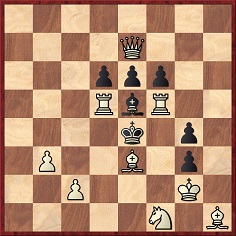
Mate in two
(2379)
It was suggested [on page 81 of the 2/2000 New in Chess] that in 50 Shortcuts to Chess Victory Koltanowski gave Eastern Europe as the place of his birth. Maybe yes, maybe no, maybe maybe. Dated 1997, the booklet had one of its eight pages taken up with a third-person account of Koltanowski’s life, the second paragraph of which began: ‘Born September 17, 1903, in Eastern Europe, Mr Koltanowski moved to Antwerp, Belgium when he was a child …’
In contrast, the biographical note on the back cover of an earlier (12-page) booklet, 100 Shortcuts to Chess Victory, referred to ‘Mr Koltanowski, who was a national chess champion of his native Belgium at the age of 17 …’ (italics added here). On the other hand, turning back again to 50 Shortcuts … we find, ‘he became national chess champion of Belgium at 20’. In fact, he was 19. With Koltanowski, factual matters are seldom straightforward, and, adding to the confusion, he also penned a booklet (another eight pages) entitled 51 Shortcuts to Victory.
(2383)
A master more skilled at blindfold chess than orthography was Koltanowski. On page 59 of With the Chess Masters (San Francisco, 1972) he referred to ‘Duncan Philidor’. A sample of other lapses in the book was listed in C.N. 1234 (see above, as well as pages 159-160 of Chess Explorations), and these included the point that on page 92 he gave E. Sapira’s name as ‘Sapiro’ (five times). For example:
‘Sapiro was a witty hunchback with great chess talent (He was killed by the Nazis in the 1940 invasion of Belgium.)’
However, on page 102 of their 1988 book Histoire des maîtres belges M. Wasnair and M. Jadoul stated (without, unfortunately, specifying any source) that Sapira died two or three years later:
‘En 1942-43, afin d’échapper à l’holocauste nazi, il traverse la France et c’est là, au pied des Pyrennées qu’il disparaît, victime d’un “Thénardier” qui le détrousse et le vend aux Nazis.’
(2906)
The full text of C.N. 2906, including more information about Sapira and a game of his annotated by Alekhine, is given in Alexander Alekhine Miscellanea.
It was from Allentown, PA that Paul Schmidt wrote to Chess Life & Review in 1976 to straighten out the following paragraph by Koltanowski which had appeared on page 89 of the February 1976 issue:
‘During the Second World War Dr Alexander Alekhine, then Champion of the World, participated in a number of tournaments. In 1942 he played in Prague, under the sponsorship of Germany’s Nazi Youth Association. There he met 18-year-old Klaus Junge of Leipzig, who was acclaimed as a future world champion by the German press, and who was stabbed to death in a chess club fight in 1942!’
On pages 212-213 of the April 1976 issue Schmidt wrote:
‘Klaus Junge, one of my best friends, was not “stabbed to death in a political brawl in a chess club in 1942” as stated by George Koltanowski in the February issue. He died in combat, as a German officer, on the last day but one [sic] of World War II, i.e. in 1945. Nor did Alekhine meet him for the first time at the tournament in Prague, 1942, where they tied for first and second place. They met for the first time at the 1941 tournament in Warsaw-Cracow, their individual game ending in a draw, … and then again in 1942 at the six-master double-round tournament in Salzburg, each winning one game … [as well as two other tournaments before Prague, 1942].
Klaus Junge also did not come from Leipzig. He was born in Chile as the son of German parents who, unfortunately, returned to Germany to get a better education for their children than was possible at that time in Chile – only to lose all their three sons to Hitler’s war. His parents lived in Hamburg.
About the only correct reference to Klaus Junge in Mr Koltanowski’s article is to his chess genius: had he not died in 1945 he would indeed have become a formidable contender for the world championship. He was equally fond of combinatorial and positional play, and his style was completely mature even at age 18. My book Schachmeister Denken! (Walter Rau Verlag, 1949) is dedicated to the memory of Klaus Junge.’
(2926)
A national championship. Certain players collude by delaying games among each other in order to determine which of them has the best chance of unhorsing the tournament front-runner. One participant even throws a game, allowing himself to be mated on move two.
For information about this remarkable episode we are grateful to Luc Winants (Welkenraedt, Belgium), who writes as follows:
‘I would like to draw your attention to my own website, which is dedicated to the history of chess in Belgium. Concerning Koltanowski, about whom you have written recently in C.N., the account of the second Belgian Championship, held in Antwerp in September 1922, reveals some interesting details [http://users.skynet.be/jardinsdecaissa/belch/belch22.html – link no longer available]:
One chronicle, written by Edouard Verschueren, a friend of Edgard Colle, for La Flandre Libérale, 4 October 1922, states the following:
“C’est à ce moment que les joueurs anversois se sont liés contre le champion, dans l’espoir de lui ravir encore le titre. Volontairement on remettait des parties entre les joueurs anversois (Koltanowski-Dunkelblum), afin d’attendre le résultat de M. Colle et d’avantager alors le joueur ayant encore des chances; on lui cherchait toutes les difficultés possibles au jeu, tandis que, d’autre part, des parties entre Anversois finissaient dans des limites de temps ridicules, et ainsi M. Koltanowski gagnait la partie suivante contre M. Boruchowitz, ancien champion de Belgique:
1 f3 e5 2 g4 Dh4 mat. Ce n’est évidemment pas des parties pareilles qui donneront un lustre à nos joueurs anversois; le plus petit débutant aurait évité cette gaffe ... volontaire.”
Thus, as you can see, the game between Boruchowitz, the winner of the first championship in 1921, and Koltanowski finished after only two moves: 1 f3 e5 2 g4 Qh4 mate.’
Despite the plot against him Colle won the event and the national title, half a point ahead of Koltanowski.
(2928)
In the mid-1930s Aristide Gromer was one of many figures (Alekhine, Capablanca, Flohr, Koltanowski and Lilienthal were others) who toured Spain giving simultaneous exhibitions, and it seems that the highlight of the Frenchman’s stay occurred in Lugo. El Ajedrez Español, January 1935 (page 143) reported that he had given a display on 128 boards, scoring +105 – 6 =17 in ten hours. The magazine published a number of games played by Gromer during his visit (none particularly striking), and on page 334 of the July issue he wrote a brief article flattering Spanish chess.
On page 472 of the October-November El Ajedrez Español G. Koltanowski wrote mild criticism of Gromer’s conduct in Spain, but the same adjective hardly applies to the attack he launched on page 78 of the 14 October 1935 issue of CHESS:
‘I am going to write some very unpleasant things about Gromer, and I hope he reads them. He has victimized Spanish chess circles long enough and is doing the game a lot of harm, and I am publishing these details at the request of the committee of the San Sebastián Club, in the hope that they might save a few people from him who might otherwise be duped.
Gromer’s habit is to turn up suddenly in some small town, announce that he is penniless and beg the president of the chess club to arrange a simultaneous display for him. A display is arranged, and he receives a large fee. Now, instead of leaving, he stops. A few days later he calls again and reveals that he has borrowed large sums of money from various members: just arrange one more simultaneous display and he will pay off the debt and leave! Again a display is organized but instead of paying off the debt, he pays half. A week later he turns up and asks for another display to pay the remainder of the debt off. By the time the club gets rid of him he has mortgaged their finances so badly that they are unable to plan any sort of ambitious programme for years to come.
In San Sebastián he has not even paid back his debts. The last display he gave there was at three pesetas a board, an absurdly high fee. And they can’t get rid of him: he is staying at the best hotel and they are wondering who is going to pay the bill.’
We make no comment on the above reportage, except to reiterate that Koltanowski’s lifetime track-record of inaccuracy is such that rigorous scepticism is required concerning anything written by him, whether malignant or benignant.
(2946)
Below is a photograph of the participants in Spa, 1926:
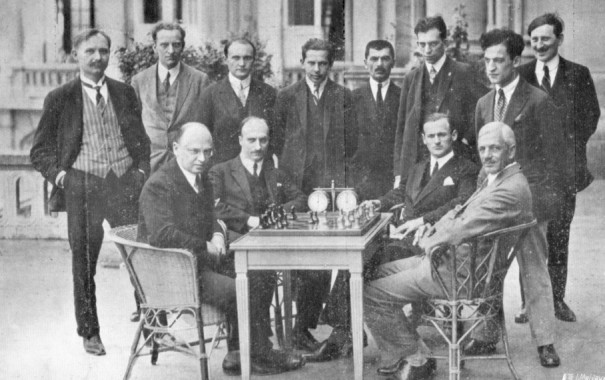
From left to right (standing): A.
Lenglez, M. Varlin, A. Tackels, A. Dunkelblum, V. Soultanbéieff,
I. Censer, G. Koltanowski, J. Davidson.
Seated: S. Tartakower, M. Romih, F. Sämisch, Sir George Thomas.
(3554)
‘Now that the drawing for the Candidates’ Matches has been held, it is a natural thing for everyone to make predictions as to who will end up in the challengers’ [sic] seat next year playing against Boris Spassky of the USSR for the world title.’
So wrote George Koltanowski on page 4 of Chess Digest Magazine, January 1971, although an alternative view is that making public predictions is unnatural, pointless and vulgar. In any case, Koltanowski’s chess judgement resulted in the following declaration on Fischer v Taimanov:
‘I believe it will be a very close match, with Fischer winning it 5½-4½.’
Fischer won 6-0.
(3561)
In an article on page 195 of the September 1971 Chess Digest Magazine William Winter was given the Koltanowski treatment:
‘Winter was a heavy drinker and one of the best chess stories I know is the one of the committee that was formed in 1927 just before the International tournament was to take place in London. They raised one hundred pounds (about 350 dollars then) to support William Winter, so that he could win the event with great ease. In the first round William Winter came into the playing hall, breathing harshly and he beat the great Richard Reti. The next day, Winter weaved into the playing room, sat down at his board and beat the perplexed Aron Nimzowitch. The third day Winter staggered to his seat and beat my co-patriot, Edgar[d] Colle. It looked like it was going to be a big triumph for British Chess. But the expectations were short-lived. Winter had spent all the raised funds on booze in the first three days, and the so-called Winter Committee couldn’t raise another penny from its supporters. The first prize was only one hundred pounds! William Winter arrived sober for each round after the third and lost every game.’
Let us, firstly, compare the above with the complete record of the tournament given in M.A. Lachaga’s comprehensive book on the event, published in 1968. William Winter’s round-by-round performance was as follows:
1: lost to Fairhurst
2: beat Buerger
3: beat Thomas
4: drew with Marshall
5: lost to Bogoljubow
6: drew with Yates
7: lost to Tartakower
8: beat Nimzowitsch
9: drew with Colle
10: lost to Réti
11: beat Vidmar.
This placed him among the prize-winners, i.e. equal sixth with Réti. He did not defeat Réti or Colle; nor did he play in the first three rounds any of the masters named by Koltanowski. About the alleged ‘Committee’, we know nothing, but it may be wondered who would put together £100, or any other sum, so that W.W. could win ‘with great ease’ a tournament which included Bogoljubow, Marshall, Nimzowitsch, Réti, Tartakower and Vidmar. Moreover, £100 (the amount which, Koltanowski alleges, was spent on alcohol consumption within three days) was then roughly $500, not $350. In today’s money it would come to over $5,000. Finally, the first prize in the tournament was not £100 but £50 (BCM, August 1927, page 335).
Thus every verifiable ‘fact’ in Koltanowski’s yarn is false. Why? Was he guilty, once more, of ‘mere’ sloppiness and doltishness (page 341 of the September 1922 BCM was certainly inspired when it spelt his name ‘Klotanowski’) or was there also a darker side to his compulsive fabrications? William Winter was indeed known to drink heavily, but what sort of human being would, in ‘one of the best chess stories I know’, publicly ridicule a deceased master for alcoholism without making the remotest effort to be truthful?
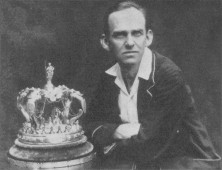
William Winter
(3624)
The following item by G. Koltanowski on page 83 of the December 1969 Chess Digest Magazine comes to mind:
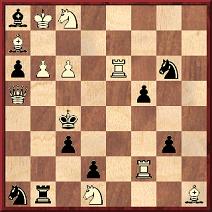
‘White to play and mate in three moves. The author of the problem wrote “... a horrible looking think [sic], which was set up to be difficult and not elegant ...” It was shown to the Masters participating at the New York International Tournament of 1893. It took Dr E. Lasker, champion of the World at that time, 35 minutes to solve. Pillsbury took 40 minutes. The others were way off.’
Quickly passing over Koltanowski’s customary inaccuracy (in 1893 Lasker was not world champion), we note that he did not name the composer. As Michael McDowell mentions to us, the problem is number 247 in A.C. White’s Sam Loyd and His Chess Problems (Leeds, 1913). Pages 200-201 identify it with the caption ‘Manhattan Chess Club, 1893’ and quote Loyd:
‘No. 247 is a horrible looking affair designed for a State Solving Contest. It was evidently posed for difficulty and not for elegance.’
What was the source of Koltanowski’s assertion about the (surprisingly long) time taken by Lasker and Pillsbury to solve the problem?
(3751)
What is the earliest known sighting of the well-known story about Capablanca turning up in his tennis gear to resume a game of chess against Yates at Hastings? See, for instance, pages 16-17 of The Bright Side of Chess by I. Chernev (Philadelphia, 1948).
We open the bidding with the following ‘once’ version by G. Koltanowski on page 180 of CHESS, 14 January 1936:
‘Capablanca once turned up to play off an adjourned game against Yates, dressed in white flannels and with a tennis racquet in his hand. Didn’t we chuckle when, four hours later, with the darkness of night outside the congress room, he was still playing – chess, not tennis.’
Koltanowski wrote similarly on page 80 of With the Chess Masters (San Francisco, 1972), but on page 24 of Chessnicdotes II (Coraopolis, 1981) he underscored once again his worthlessness as a chronicler by stating that the episode had occurred ‘in the 1929 tournament at Hastings’ in a game between Capablanca and Vera Menchik.
(4114)
Now an earlier (and, again, different) version by Koltanowski can be presented, from page 122 of the 1 December 1932 issue of his magazine Chess World:
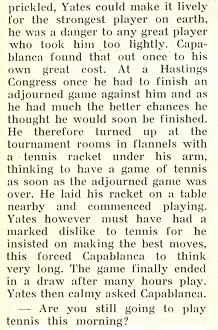
His account in CHESS spoke of ‘the darkness of night’, but now there is a reference to playing tennis ‘this morning’. More substantively, Capablanca and Yates had only one draw in any Hastings tournament, on 4 January 1930. Koltanowski was there, playing in the Premier Reserves event, but since the Cuban’s game against Yates was not adjourned (it lasted only 26 moves), the confusion continues.
(5549)
Yet another version of Koltanowski’s anecdote, from page 19 of his book Torneo internacional de Hastings 1935-1936 (Barcelona, 1936):

(7876)
On page 92 of the Hobbies for Everybody chess section mentioned in the preceding item [C.N. 4190] H.R. Bigelow wrote:
‘I learned the moves from a Swiss governess in Lucerne, Switzerland, at the age of ten. For several years afterward I did not even look at a chessboard. Then I met a lad slightly my senior, in a boarding school at Mondragone, Frascati, a few miles outside of Rome.
We played together occasionally in the year I spent there. His superior skill awakened on my part a natural desire to surpass him. (He later became one of Italy’s strongest players and a member of their team in the international team tourneys. His name is Count Antonio Sacconi.)’
Mention of Sacconi, who became champion of Italy in 1935, reminds us of the following extract from an article, if it merits that term, by George Koltanowski entitled ‘Koltanowski, as usual!’ on page 412 of CHESS, 14 July 1936:
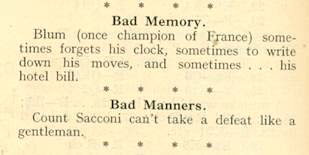
Koltanowski gave no substantiation for his attack on Sacconi, any more than he backed up his assault on the mysterious ‘Blum (once champion of France)’.
(4191)
C.N. 4191 reproduced from CHESS a brief but sharp attack by George Koltanowski on a player named Blum, who he said was ‘once champion of France’. We have found no record of anyone of that name winning the French championship.
Koltanowski wrote more extensively about ‘Dr Karl Blum of Paris (?)’ on pages 106-108 of With the Chess Masters (San Francisco, 1972), again accusing him of financial impropriety, and adding that Blum was imprisoned in Spain. ‘But after the Madrid tournament of 1936, Dr Blum disappeared from the face of the earth! Or seemed to. Some said he was in the ...’ etc., etc.
Koltanowski’s book (page 106) was demonstrably accurate on one matter: a player named Blum did win the championship of Paris in 1932. He came ahead of Rossolimo and Halberstadt (L’Echiquier, 28 January 1933, page 1944).
(4255)
Dominique Thimognier (St Cyr sur Loire, France) points out that whereas George Koltanowski referred to ‘Karl Blum’, a report on the 1932 Paris championship on page 230 of the October 1932 La Stratégie had ‘O. Blum’.
(4260)
With regard to the player named Blum whom G. Koltanowski attacked for financial impropriety, Dominique Thimognier notes on page 422 of the October 1933 BCM a reference, in connection with the French championship, to ‘Dr Oscar Blum (who has been spending some time in London since the Folkestone Congress)’. Our correspondent also mentions that page 6 of the December 1932 issue of the Bulletin de La Fédération Française des Echecs (which had the results of that year’s Paris championship) stated that Blum was Lithuanian. In Folkestone he participated not in the Olympiad but in the ‘General Congress’, finishing second, half a point behind Znosko-Borovsky.
(5251)
C.N. 4191 quoted two snippets from an ‘article’ by Koltanowski on page 412 of the 14 July 1936 issue of CHESS. Below in all its splendour is the whole thing:
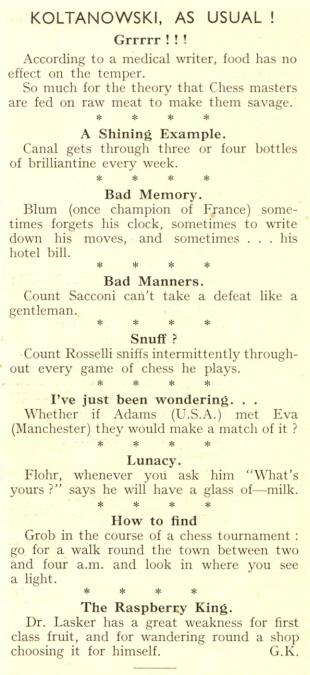
(6160)
From page 73 of Koltanowski’s Chess Annual 1955 (San Francisco, 1955):
‘Backward pawn – An unsupported pawn which cannot be moved immediately into the protection of another pawn.’
‘Center – Generally refers to the king’s and queen’s files and to a lesser degree to the bishops’ files.’
‘En passant – (Fr., in passing) The capture of a pawn which has moved from its second to its fourth rank by an opposing pawn which stands on its own sixth rank.’
‘Hanging pawns – Two or more connected pawns unsupported by others.’
If these definitions are taken literally, as definitions are supposed to be, an intriguing assessment may be made of this imaginary position:
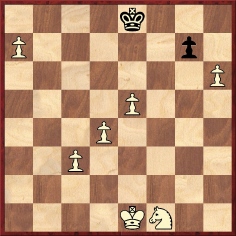
Black to move
White, to follow Koltanowski, has backward pawns on a7 and h6, quite apart from his hanging pawns on c3, d4 and e5. His knight is in the centre. Black advances his own backward pawn (1...g5), and White captures it en passant with his h6-pawn.
(4559)
Eliot Hearst (Tucson, AZ, USA) asks if any reader can iron out a discrepancy regarding Koltanowski’s 34-board blindfold display in Edinburgh on 20 September 1937. Page 44 of George Koltanowski: Blindfold Chess Genius (Anaheim, 1990) stated that he drew on board nine against W. Geddes, whereas the game-score itself on page 52 showed Koltanowski as victorious over that player.
(4593)
From our feature article which discussed Blindfold Chess by Eliot Hearst and John Knott (Jefferson, 2009):
There is also investigation of such curious episodes as the claim, from the early 1920s, that in Spain José Juncosa played 32 blindfold games simultaneously (pages 66-67). The co-authors grapple with the perennial problem of matching George Koltanowski’s statements with the public record, although they take quite an indulgent view of his ‘many inconsistencies, unfounded remarks, and errors in his writings’ (page 83). Particular difficulties arise with an important matter: the claims of János Flesch that he gained the world record by playing 52 games simultaneously in Budapest in 1960. Those claims are considered untenable, but the detailed examination (pages 99-110) states that ‘the two authors of this book disagree on how to view Flesch’s overall status as a blindfold champion and how to treat opinions of others about him’. The claims of Dimitrije Bjelica to have played 56 blindfold games in Igalo, near Herceg Novi, in 1997 are, of course, easier to dismiss (pages 130-131).
Luc Winants (Boirs, Belgium) provides this photograph:
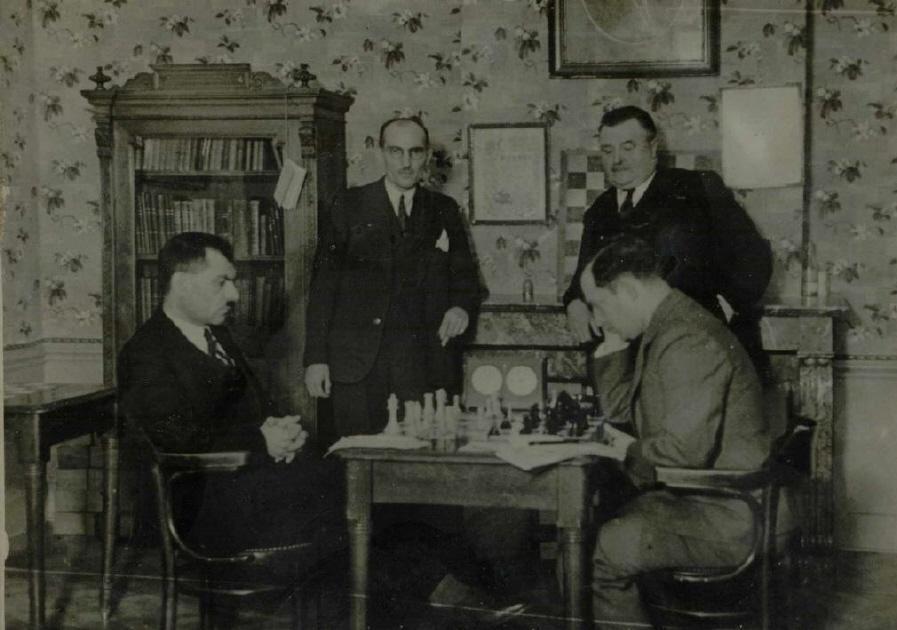
Our correspondent comments:
‘This picture was taken during the third match-game between Victor Soultanbéieff and George Koltanowski in Brussels on 25 June 1935. I received it as a present from the daughter-in-law of Akiba Rubinstein (the widow of his eldest son), and I believe that it has never been published before. The persons standing are Demey and Van Meenen.’
(4701)
In the context of our Chess Records article we seek more information about George Koltanowski’s column in the San Francisco Chronicle. The newspaper’s obituary on 7 February 2000, by Steve Rubenstein, reported that Koltanowski ‘wrote more than 19,000 chess columns for the San Francisco Chronicle’ and that ‘his column, which appeared in the Chronicle every day without interruption for 52 years, was the longest-running daily chess column in history’.
What were the exact dates of Koltanowski’s first and last columns in the Chronicle?
(4799)
John Donaldson (Berkeley, CA, USA) reports that George Koltanowski’s first chess column in the San Francisco Chronicle was published on page 7L of the 9 May 1948 issue. The top part is reproduced here:
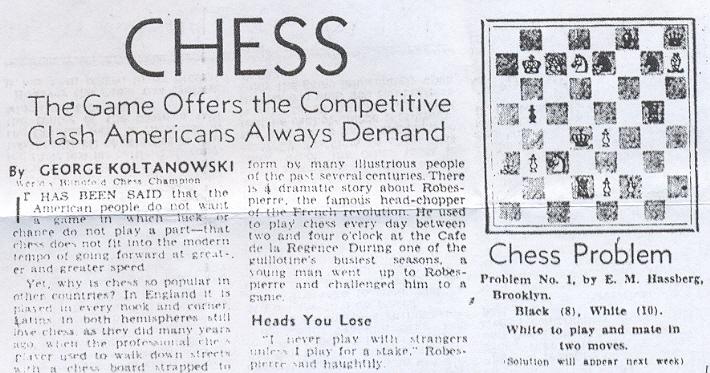
Koltanowski continued the column until his death in February 2000, i.e. for a total of almost 51 years and nine months.
(4841)
From John Donaldson:
‘George Koltanowski died on 5 February 2000, but a daily column bearing his name continued up to 27 February. On 28 February Shelby Lyman started and has appeared continuously to the present.’
(5267)
Calle Erlandsson (Lund, Sweden) draws attention to the subscription rates on page 2 of the first issue of George Koltanowski’s magazine The Chess World, 1 October 1932:
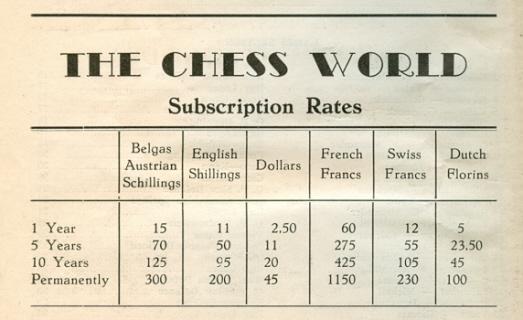
Given that the magazine ceased publication less than a year later, with a double number (10-11) dated July-August 1933, our correspondent wonders how many people subscribed for five years, ten years or permanently, and what happened to their money.
For our part, we should also like to know the outcome of Koltanowski’s ‘latest scheme’, as published on page 116 of the May 1942 CHESS:
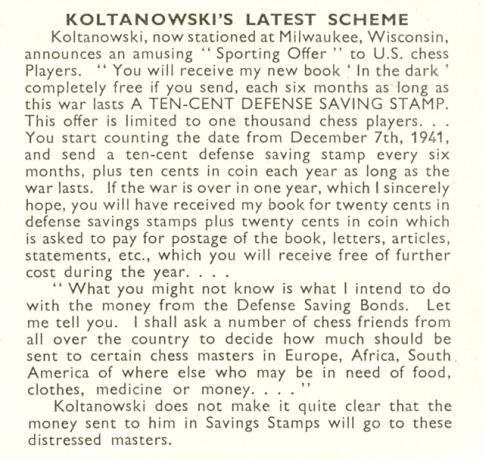
The book referred to (‘In the dark’) was eventually published 13 years later as Adventures of a Chess Master, at $4. The 1986 algebraic edition took the title In the Dark.
C.N. 3255 (see page 249 of Chess Facts and Fables) mentioned a reference to ‘Sir Henry’ Golombek on page 40 of The Sporting Scene by George Steiner (London, 1973). Below are some references to ‘Sir’ Harry Golombek in US sources:
Golombek, of course, was never knighted. He was merely given the OBE for services to chess, in 1966.
(5674)
Dr Golombek’, ‘Sir Henry Golombek’ and ‘Sir Harry Golombek’ have been mentioned in C.N.s 3226, 3255 and 5674, and Geoff Chandler (Edinburgh) now adds a prominent specimen on page 605 of the October 1972 Chess Life & Review:
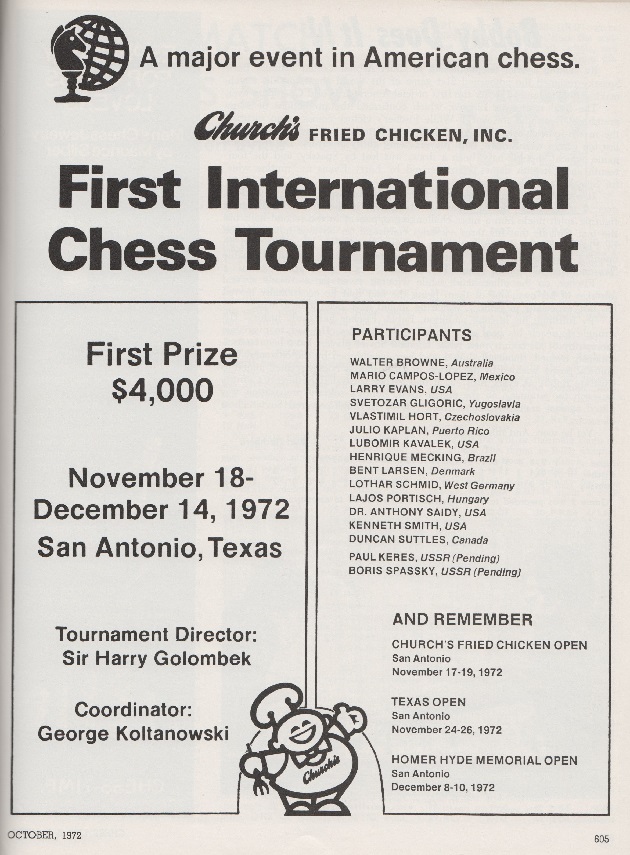
The announcement was repeated without correction on page 669 of the November 1972 Chess Life & Review. That latter issue (page 704) also had ‘Sir Harry Golombek’ in a feature about the San Antonio tournament.
‘Sir Harry Golombek’ is a mistake to be expected from Koltanowski; see, for instance, page 5 of Colle System (Coraopolis, 1984). Another example from the United States is the frontispiece of the book by Larry Evans and Ken Smith on the 1972 world championship match. That occurrence was criticized on the cover page iii of CHESS, June 1973, yet on the cover page iii of the previous month’s issue the magazine itself had referred to ‘Professor H.J.R. Murray’. For further instances of that error see The Chess Historian H.J.R. Murray.
(10855)
Two appearances:
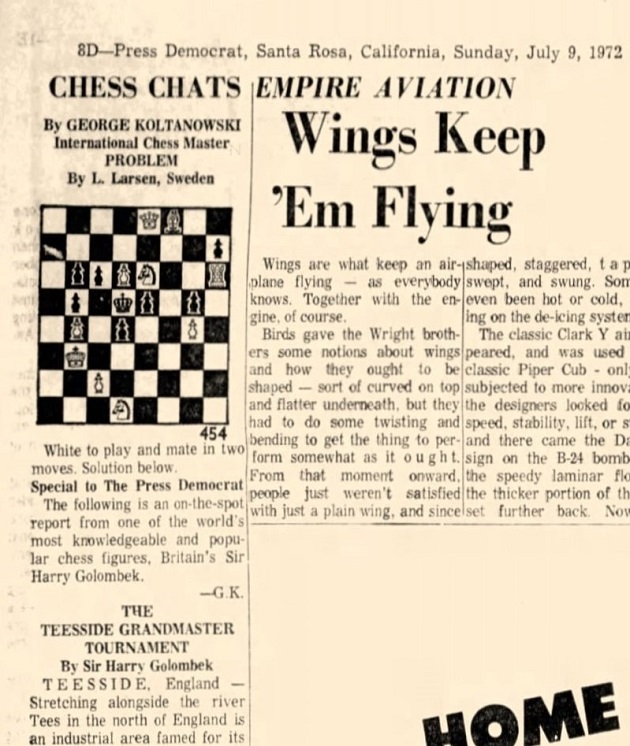
The FamilySearch.org website mentioned in C.N. 7139 has a reference to Georges Gustave Koltanowski. The ‘Gustave’ was news to us.
(7140)
Koltanowski’s book Torneo internacional de Hastings 1935-1936 (Barcelona, 1936).
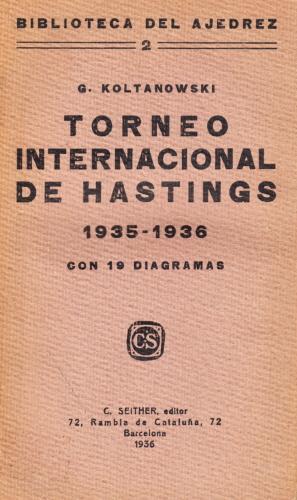
The Koltanowski touch is reflected in, for instance, the book’s references to Buenger, Friffith, Gensberg, Golombeck, Gross, Michel, Pire, Rubistein, Tartalkower, Vitmar, Womorsly, Wonorsly and even, on page 32, Koltanowki.
(7781)
From page 73 of Chessnicdotes II by G. Koltanowski (Coraopolis, 1981):
‘During the International tournament in Paris, 1927, Dr Alexander Alekhine had all of the contestants up to his hotel suite. He had just returned from Argentina, having beaten Jose Raoul Capablanca for the world title in Buenos Aires. After a special rapid transit round robin tournament, coffee, tea, whiskey, cake and “klatch”, I managed to corner our host and asked him: “Is there anyone in the world today that could take the world title away from you?” Alekhine twiddled his blond hair and smilingly replied, “Non! I am the greatest!”’
Wanted: information about ‘the International tournament in Paris, 1927’.
(8158)
C.N. 3196 (see A Chess Database) mentioned the moves 1 e4 e5 2 Qh5 Nc6 3 Qxf7+, and there are many versions of the related story involving Emanuel Lasker. One ‘is-said-to’ example comes from page 90 of A History of Chess by Jerzy Giżycki (London, 1972):
‘Lasker is said to have won a game of “Alcoholic Chess” by sacrificing his queen in ridiculous fashion at the very outset of the game. The queen contained about a quarter litre of cognac; quaffing this seriously incapacitated his opponent in the ensuing complications – B.H. Wood.’
Page 283 of the August 1959 CHESS had an account reproduced from a chess programme on BBC radio:
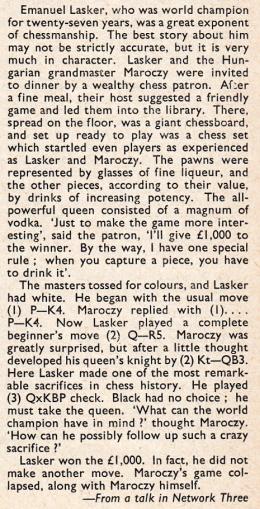
How far back can the story be traced? We recall an editorial account of a lunch with G. Koltanowski, one of the least reliable of all chess chroniclers, on page 255 of the November 1938 Chess Review:
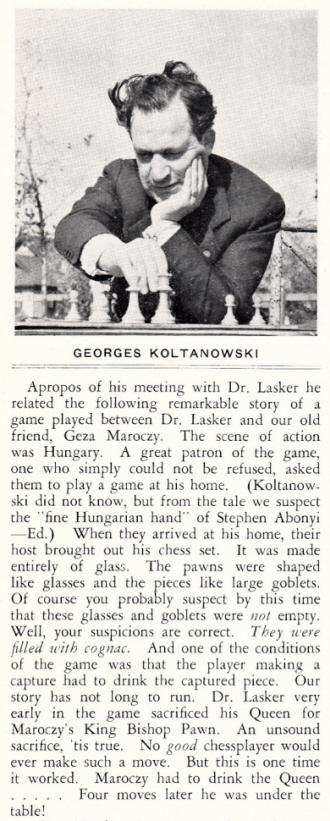
(8871)
From page 52 of the Chess Digest Magazine, March 1972:
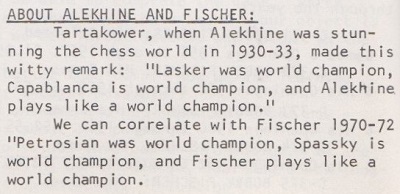
See C.N. 9384.

The above heading is from page 2 of the Chess Digest Magazine, March 1969. The article by Koltanowski included, on the next page, this item:
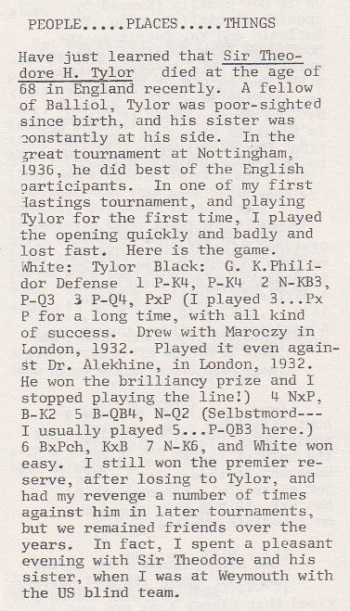
Passing over the foreseeably wretched prose, we note the following with regard to Koltanowski’s assertions about himself:
(9450)
From page 54 of Chess Marches On! by Reuben Fine (New York, 1945):

Elsewhere (e.g. on page 73 of CHESS, December 1972) the observation has been quoted as a remark by George Koltanowski to Sir George Thomas.
An editorial note (by B.H. Wood) appeared at the end of an article by Koltanowski on pages 180-181 of the 14 January 1936 issue of CHESS:
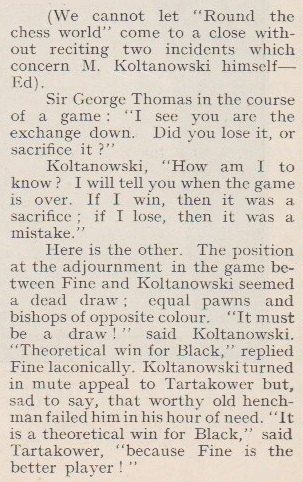
On page 87 of With the Chess Masters (San Francisco, 1972) Koltanowski named E.S. Tinsley as his interlocutor and referred to his queen, and not the exchange:
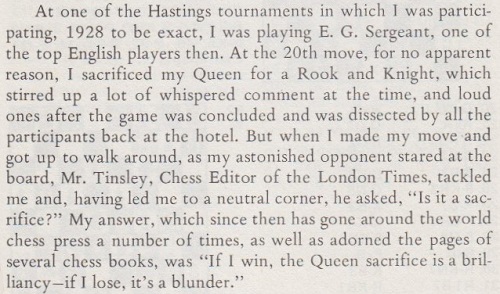
The following page showed the game (Koltanowski v E.G. Sergeant, Hastings, 31 December 1928), which reached this position after Black’s 19th move:
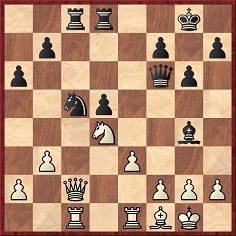
No notes were supplied, but Koltanowski punctuated his next move, Qxc5, with ‘?!’. The game was also published, storyless, on pages 83-84 of his book Chessnicdotes 1 (Coraopolis, 1978) with notes from The Field (and one analytical addition by Koltanowski towards the end of the game).
On page 54 of the second volume of Chessnicdotes (Coraopolis, 1981) it was back to Sir George Thomas and the ‘exchange’ version from CHESS in 1936:

(9451)
Bruce Monson (Colorado Springs, CO, USA) sends a bizarre article by George Koltanowski, concerning ‘a prewar living game’ between Capablanca and Nimzowitsch, from page 11 of the 25 September 1966 edition of the San Antonio Light:
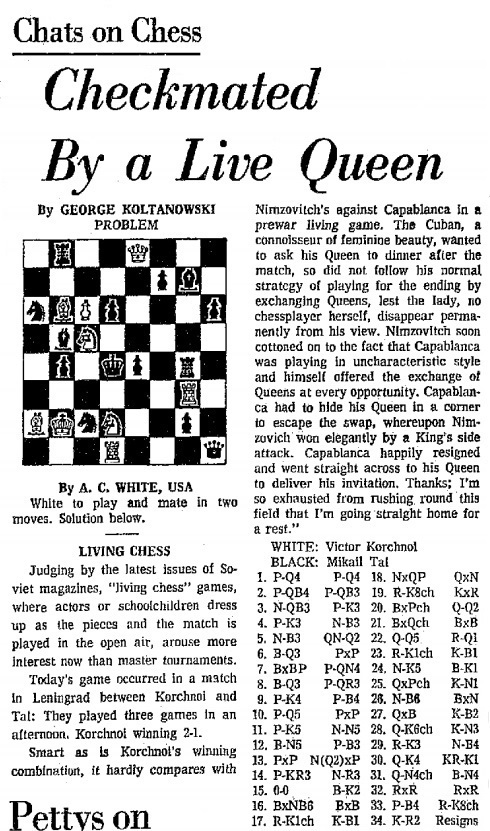
(9503)
From page 1 of the 4 December 1936 issue of Schach-Kurier:
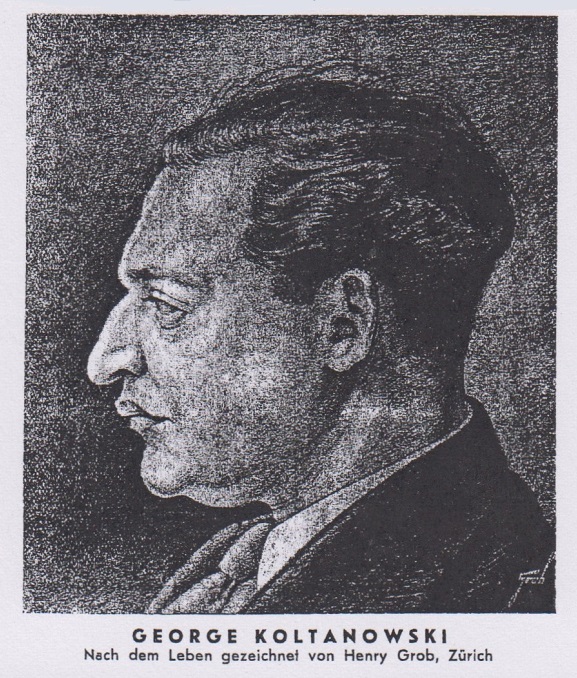
(10159)
See too C.N. 10217.
George Koltanowski could forge an anecdote from the dropping of a paperclip, but even rudimentary verification of his ‘factual statements’ is likely to highlight his unreliability.
On pages 2-3 of the March 1969 Chess Digest he had a chatty article about Tarrasch which we have already criticized for stating a) that he encountered the German master at Meran, 1924 ‘in my early teens’, and b) that Tarrasch ‘played two matches for the world title with Lasker’. (Regarding the latter point, see too A Sorry Case.)
Koltanowski repeated the above inaccuracies in his syndicated column (e.g. in the Minnesota Star, 29 March 1969, page 19, as well as the El Paso Times 29 March 1969, page 21 and 19 October 1969, page 17) and in his section on Tarrasch on pages 48-51 of With the Chess Masters (San Francisco, 1972).
A further example of Koltanowski’s approach concerns the game accompanying that article on Tarrasch: their draw at the 1927 International Team Tournament in London. Koltanowski wrote in 1969 that a friend in Antwerp had recently sent him a number of old booklets and that in one of them, on the King’s Indian Defence, ‘there was one game that I had searched for a long time’. In the above newspapers and in With the Chess Masters the reference was to a game that ‘I had tried to find for a long time’. In reality, that Tarrasch v Koltanowski game is easily found, having been published on pages 792-793 of L’Echiquier, December 1927 – with annotations by Koltanowski.
In large letters, the title of the Chess Digest article was ‘Koltys Coments’.
(10936)
Feature articles about bas de gamme chess writers can only scratch the surface, usually examining their books rather than, even more masochistically, their routine ‘journalism’. Most of Koltanowski’s output that we have seen comes from his anthologies; the thought of trawling through old newspapers for the run of his syndicated columns is unappealing.
Koltanowski’s books ought to contain the cream of the crop, but they have far too many untrue or unauthenticated yarns to be accommodated in an article [such as the present one on Koltanowski]. Here, we add a passage regarding Akiba Rubinstein from page 126 of With the Chess Masters (San Francisco, 1972):
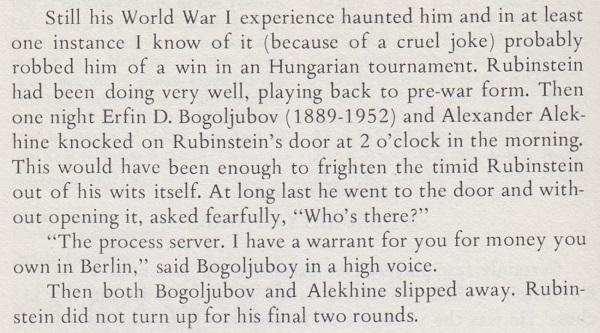
The story was reproduced on page 3 of Akiba Rubinstein: The Later Years by J. Donaldson and N. Minev (Seattle, 1995) with, generously, silent corrections to Koltanowski’s spelling, grammar and punctuation. It was then demolished.
Further examples of the way Koltanowski treated facts are given in our feature articles ‘Fun’ and Chess and Insanity. See also the references to him in the Factfinder.
Addition on 6 March 2025:
From page 105 of the May-June 1929 American Chess Bulletin:
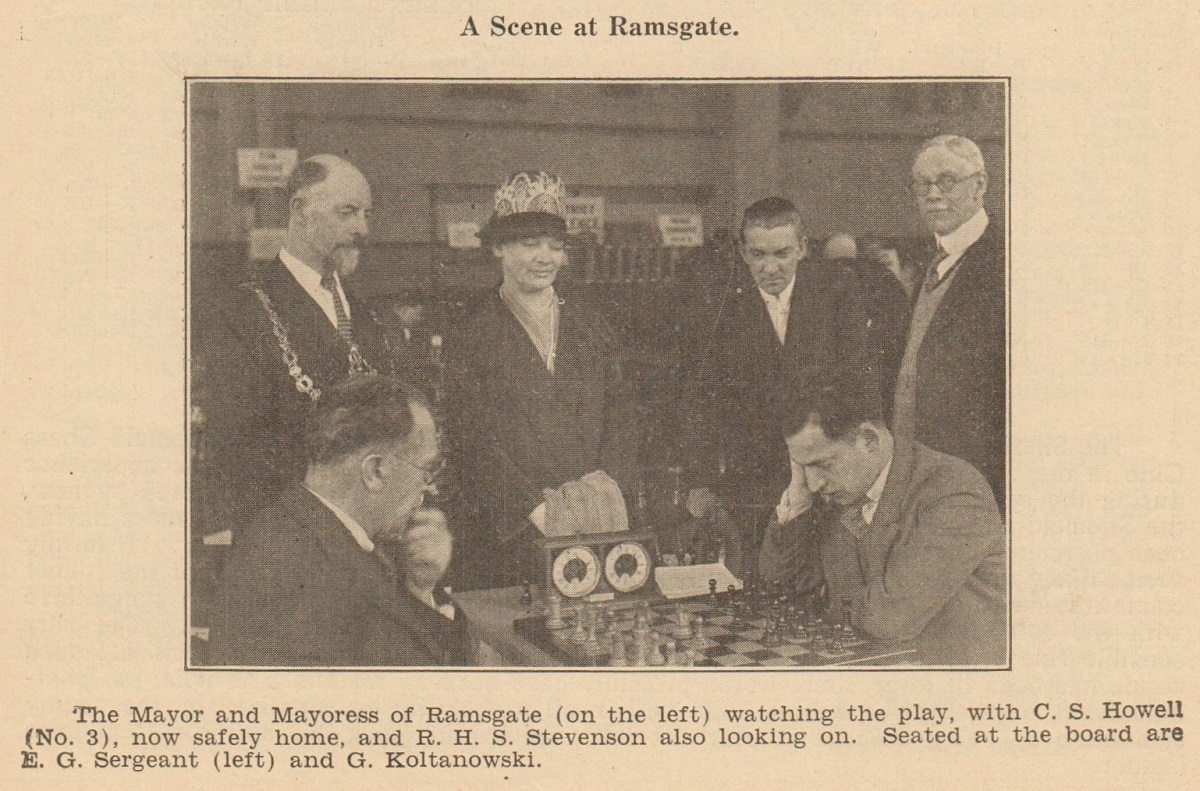
Philip Jurgens (Ottawa, Canada) writes:
‘George Koltanowski and Henry Grob contested two matches in Zurich. Their 1937 encounter was drawn, with two draws and a win apiece. In April 1953, Koltanowski won by the score of +2 –0 =3. This picture was taken during their second match, in which Koltanowski secured draws with the Two Knights’ Defence in all three of his games as Black.’
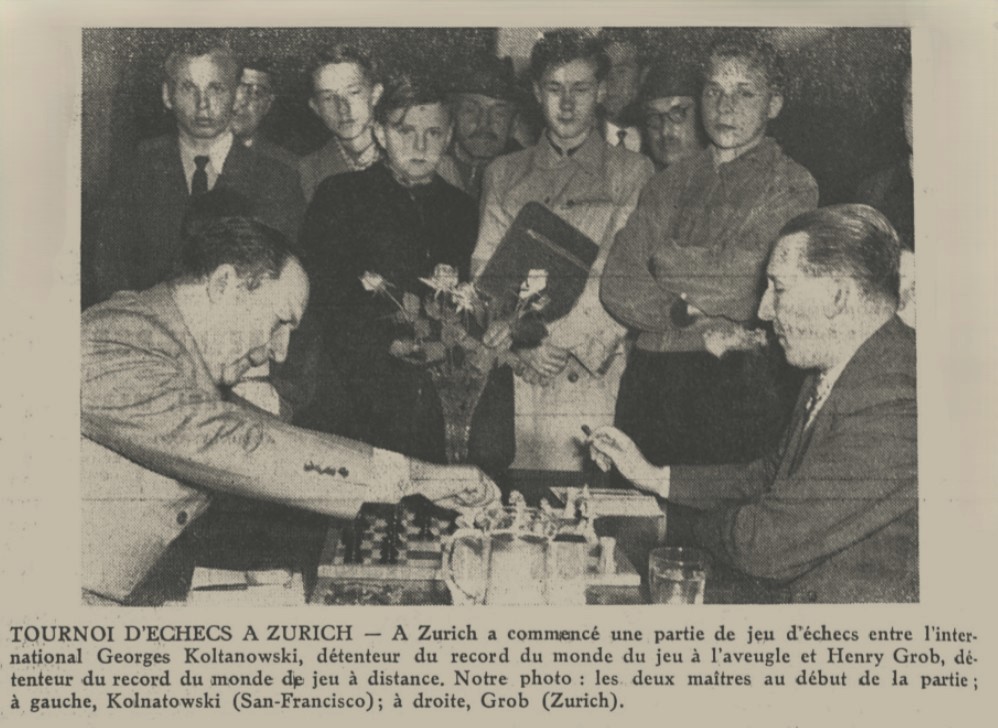
Source: Journal et Feuille d’Avis du Valais, 16 April 1953, page 2, from e-newspaperarchives.ch.
(12197)
To the Chess Notes main page.
To the Archives for other feature articles.
Copyright: Edward Winter. All rights reserved.